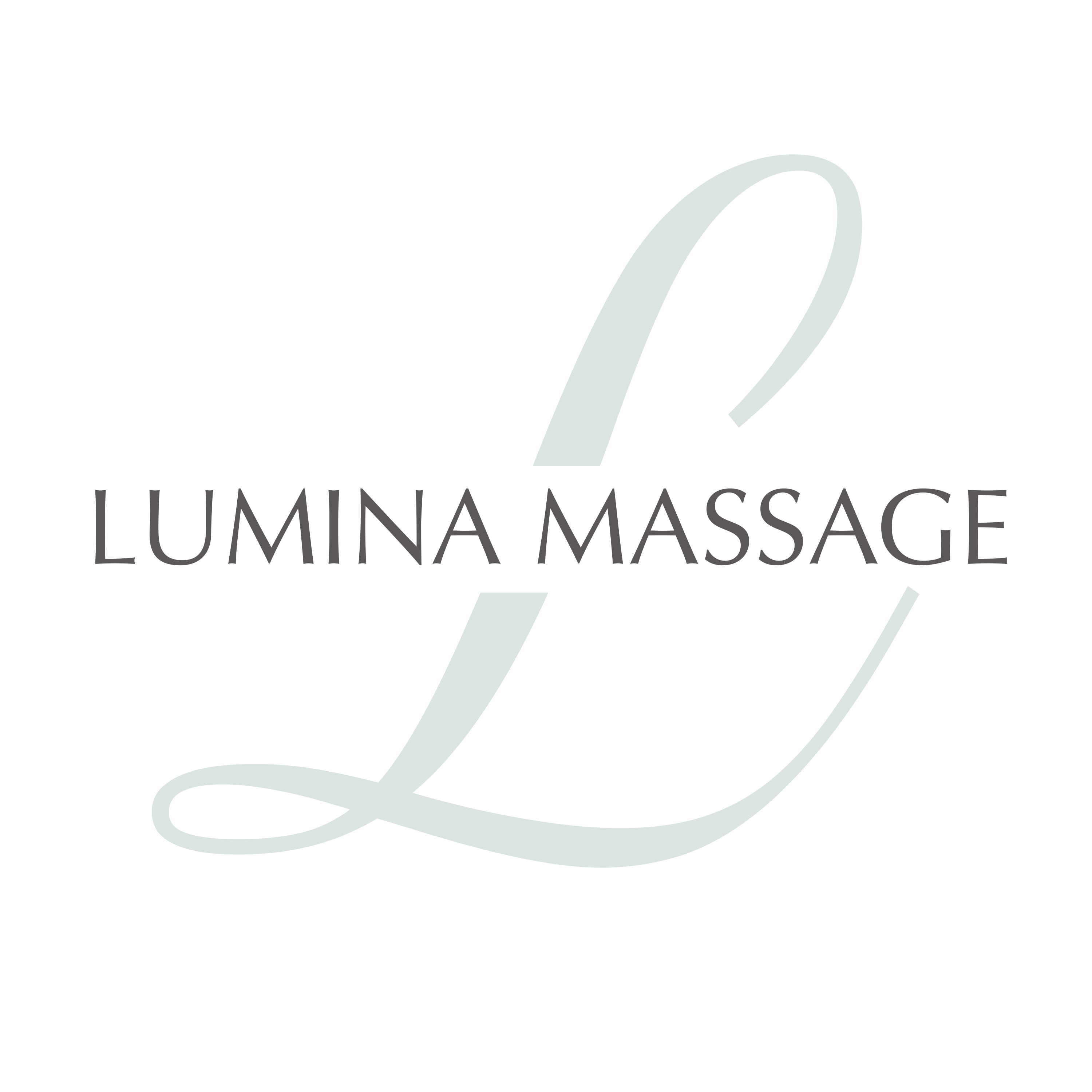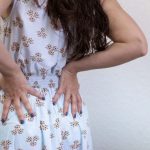Jaw Muscle Pain
When we think of jaw pain many people refer to the diagnosis of Temporal Mandibular Joint Dysfunction (TMJD). However, this term is extremely broad. In this post we will primarily focus on relieving jaw pain caused by excessive muscle tension in the mastication action (opening and closing the jaw) and its basic anatomy. The symptoms include the inability to open the mouth completely and or comfortably or chew on food without pain. Headaches may also be a symptom of tension in the muscles of mastication. Other root factors will be presented as well. The last example will be the opposing condition of slack jaw during sleep. This condition may be brought on by weak jaw muscles and or sleep apnea. In this case, the common approach to TMJ and manual therapy with specific muscles that can be released differ from spasms brought on by teeth grinding and or physical trauma.
Trismus, commonly called lockjaw, is reduced by the opening of the jaws (limited jaw range of motion). It may be caused by spasm of the muscles of mastication, the massater and pterygoids being the primary. Temporary trismus occurs much more frequently than permanent trismus.
Anatomy, Pathology and Clinical Terms
The digastric muscle is a small muscle located in the neck, just below the lower jaw. The name derived from the muscle having two different bellies (anterior and posterior) that are joined together by a tendon.
1. Muscle Spasm can cause significant pain and limitation of movement. In the jaw, it often affects one or more muscles of mastication, such as the masseter, buccinator, temporalis and the lateral and medial pterygoid muscles. Causes may include physical trauma to the head,prolonged emotional and mental stress, bruxism and postural dysfunction.
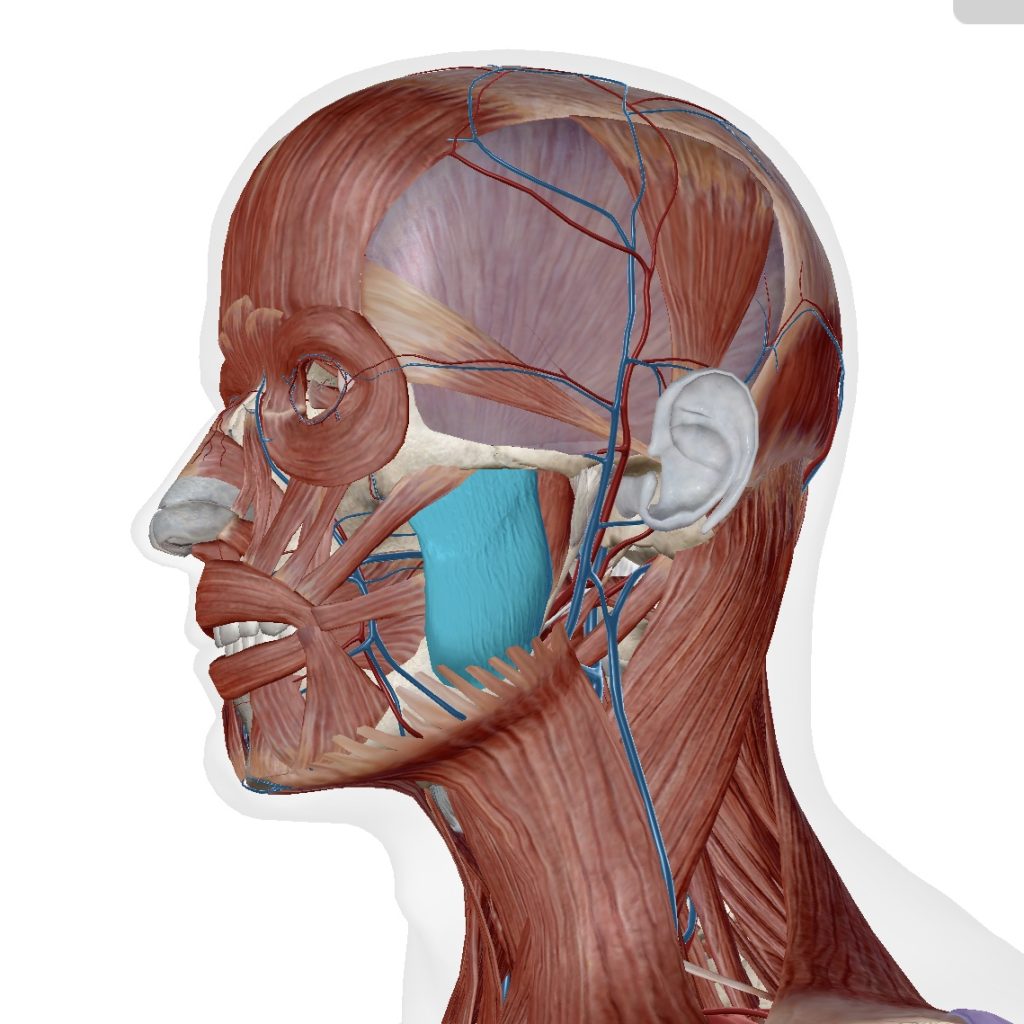
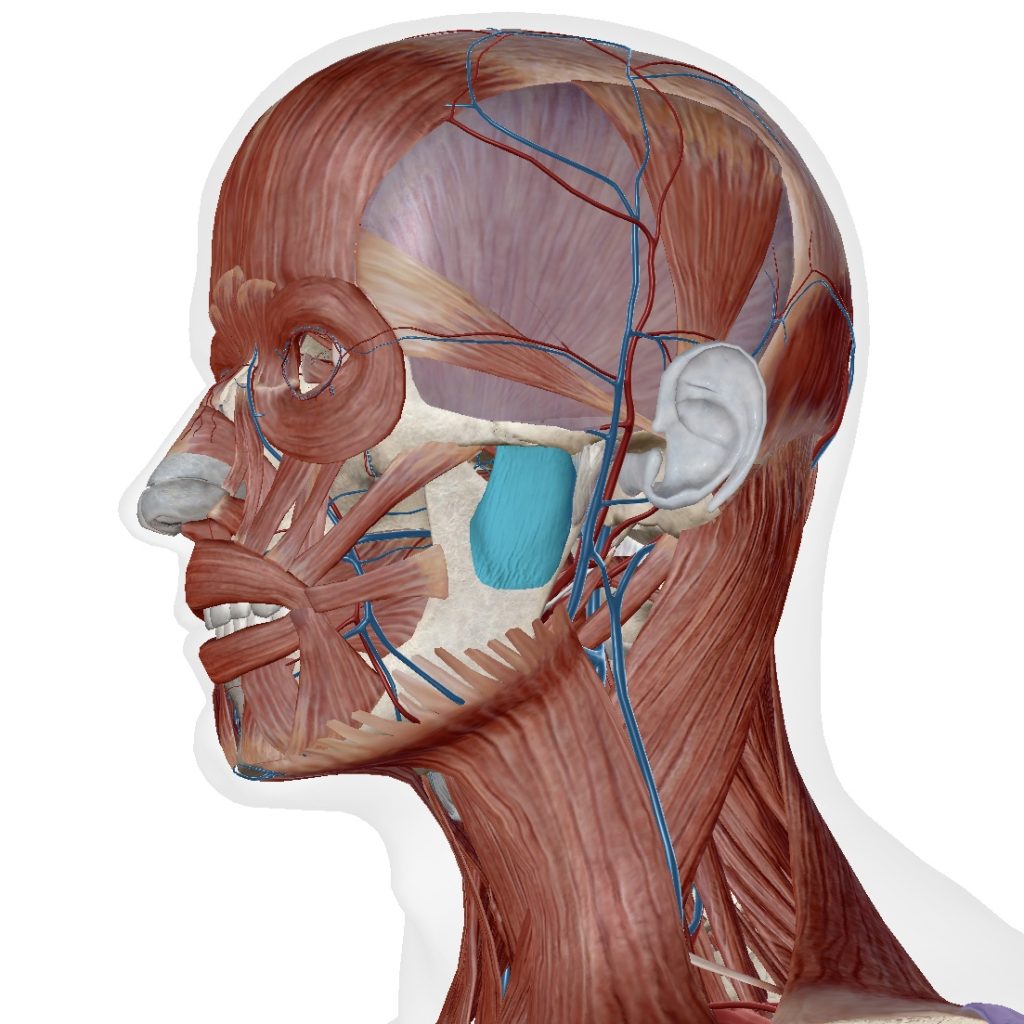
2. Cervical Postural Disorders can cause jaw pain. The anterior belly of the digastic muscle runs from the point of the chin to hyoid bone. This attachment means that when the head is protracted forward the digastrics will exert a posterior force on the mandible. With prolonged cervical protraction as occurs with poor posture or stress-related posture the mandibular condyle is pushed back against the retrodiscal tissue, eventually causing swelling, pain and gradual degeneration of the disc.
3. Temporal Tendonopathy is caused by excessive contraction of the temporalis muscle usually as a result of bruxism (teeth grinding). There is tenderness and swelling of the anterior portion of the temporalis tendon palpable just above the zygomatic arch (the bony “bump” just underneath your eyes that create the cheek bone). There may also be tenderness of the temporalis tendon where it inserts onto the coronoid process, palpable just below the zygomatic arch when the jaw is slightly open.
4. Fractures and or Physical Head Trauma Fractures of the mandible often occur at the mandibular symphysis or the condylar neck. Commonly there will be a fracture of the mandibular symphysis combined with a fracture/dislocation of one or both condyles. The mechanism of injury can be a blow to the jaw or a fall onto the chin. If manual therapy is prescribed post-surgery , treatment can usually begin within a week or two of surgery. Manual therapy or neuromuscular massage will help mobilization of the jaw,restore function and decrease pain.
citation https://www.physio-pedia.com/Temporomandibular_Disorders
The conditions above can be treated with clinical massage techniques successfully. The fracture of course could not but any spasm associated with the fracture can.
Bruxism (BRUK-siz-um) is a condition in which you grind, gnash or clench your teeth. If you have bruxism, you may unconsciously clench your teeth when you’re awake (awake bruxism) or clench or grind them during sleep (sleep bruxism). Sleep bruxism is considered a sleep-related movement disorder.
Grinding of the teeth can have causes that aren’t due to structural issues and if that’s the case, clinical massage/manual therapy can help. If there is a normal alignment of the jaw and the cause is something like intense concentration or situational anxiety (not anxiety disorder) then massage therapy can be an incredible asset to reduce overall stress. It can also relieve the specific tension in the neck and face muscles.
Some people show symptoms such as headaches, jaw pain, tooth pain, or dental problems. Misalignment with the cervical (neck) part of your spine, teeth and dental issues should be ruled out and fixed if they’re the root of the problem before clinical massage can assist in relieving the muscle pain. An x-ray is the most common diagnostic tool for ruling out an underlying issue.
Some may claim that this condition will often improve on their own but that is often not the case at all. Dental guards may help protect the teeth from damage but they do nothing to help relieve the tension brought on by muscle spasms. Someone may suffer needlessly, all the while increasing tension in a muscle that could easily be treated with manual therapy should this be the case. Often times, the need for massage in these muscles needs to be combined with a dental procedure because the discomfort of the tooth or bone fracture may cause the muscle to tense. Addressing both is a wise approach. Ask your dental professional to rule out any teeth infection or teeth grinding and educate them on clinical massage therapy for these conditions.
Slack Jaw Sleeping
Sleep apnea occurs when the mouth is open during sleep. This may be due to weakened jaw muscles. In a case such as this the opposite approach to bruxism (teeth grinding) could be helpful.
Due to the jaw being opened and stretched throughout the night, the muscles of mastication are overstretched and therefore strained. Strained muscles are sore but the muscles that require primary release are the ones located in the anterior and lateral throat. Sleep apnea is a severe disorder which negatively impacts your life and cognitive function.
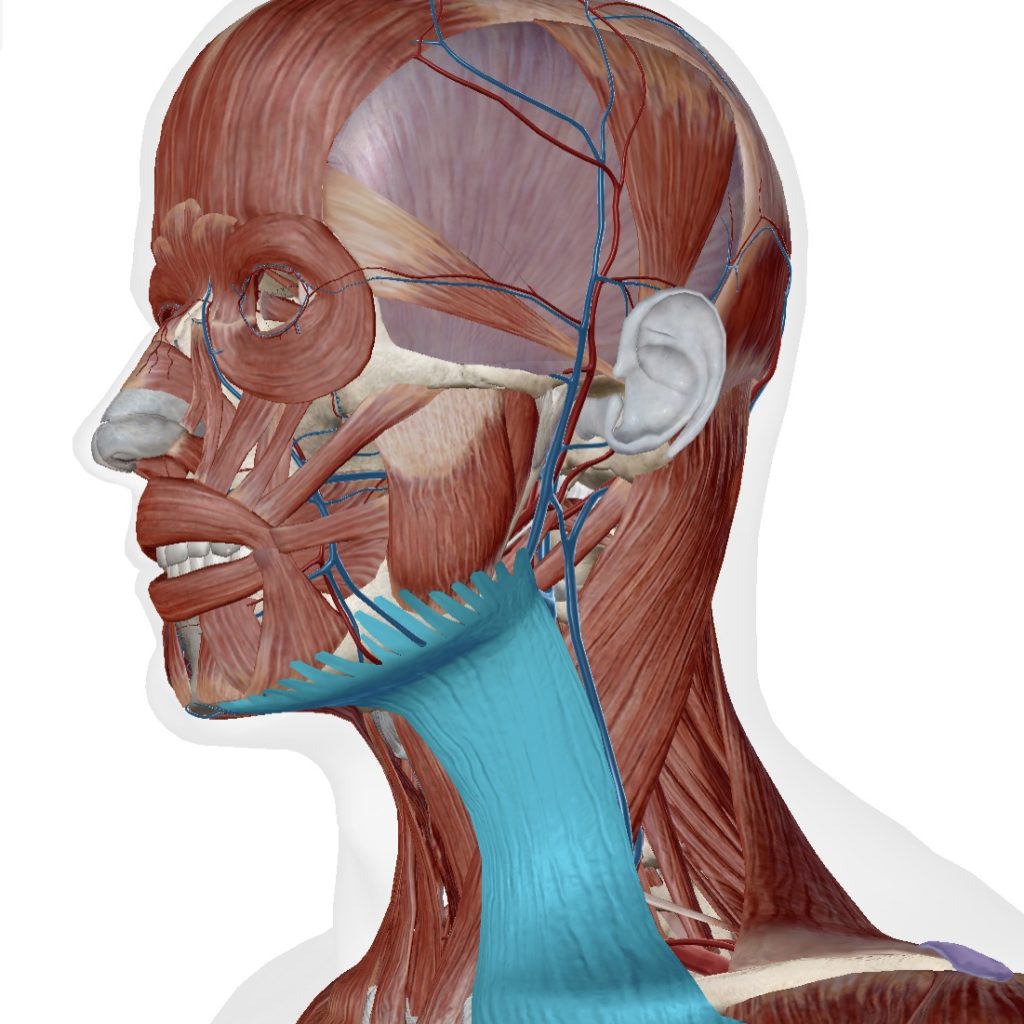
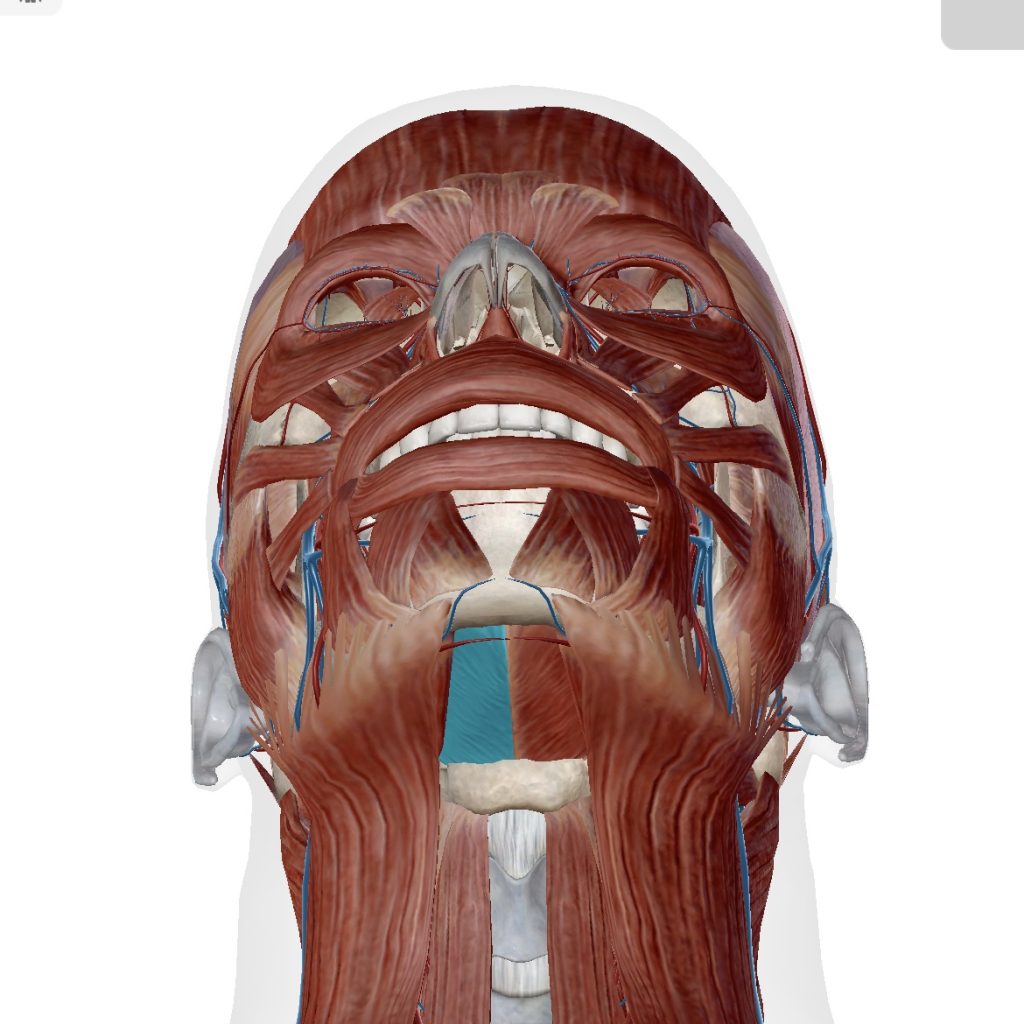
The mylohyoid muscle may be palpated gently by placing the thumbs just underneath the edge of the mandible. When you swallow you can feel this muscle contract. This muscle also retracts the mandible in its day to day action. However, when your mouth is open all night, your mylohyoid (as well as other hyoid) muscle is contracted.
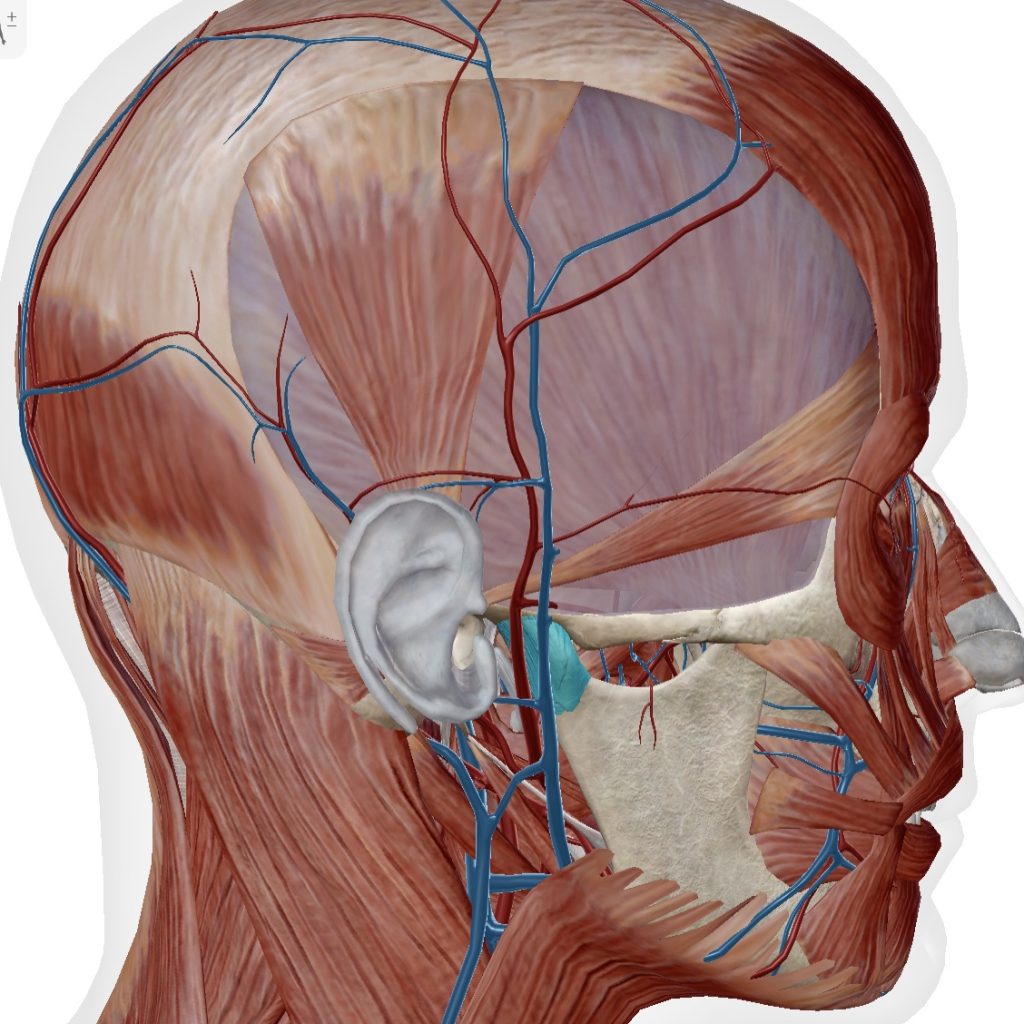
Because of the continued opening of the jaw, the joint capsule of the mandible can loosen. You may the sensation of your jaw not “closing fully”. Weak ligaments and muscles must be strengthened with corrective exercises to help the jaw close on its own once more.
When the jaw shifts out of place, it is possible that the muscles of mastication will also result in spasm. If this occurs massage of the inner jaw muscles may be helpful as well.
A chin strap placed around the jaw at night to prevent the mouth from opening could help. Avoid stretching the mandible within particular conditions and instead release the tension along the front and sides of the neck and towards the ear. I recommend having a sleep study done and having a conversation about a Cpap machine as well.
Hormonal Imbalances
Hormones play a vital role in soft tissue strengthening (e.g. ligaments, tendons and muscles etc.) As we age our hormone levels decrease. Progesterone is a sex hormone that assists with laxity of ligaments. When progesterone levels are abnormally high your ligaments lose strength. Testosterone deficiency also effects the elasticity of the body and lowers muscle tone. All needed to keep your jaw closed at night. Have a blood test measuring your progesterone and testosterone levels and if they are imbalanced discuss with your physician on ways to help you.
Neuromuscular Massage
What to Expect
Choose to work with a massage therapist that is trained in injury and has specific experience with TMJ disorders. When you arrive to your session, your therapist will ask you the location of your pain, if there is any popping or clicking in your jaw. They will also inquire about any previous falls or trauma to your head and neck. Disclose any helpful information including your current stress level, how long the pain has been there and what helps relieve it. Your therapist will also ask about any dental issues and spine related issues in the neck. Having a history with your massage therapist helps because they have worked with your body and are familiar with your lifestyle. This aides in finding the root cause much easier.
Some massage sessions may include inner mouth work depending on the severity. Your therapist may present a gloved hand or finger cot for sanitation. Placing their index finger on certain points of the muscles to release the tension. Your therapist will check in on you regarding your comfort level if they choose this approach.
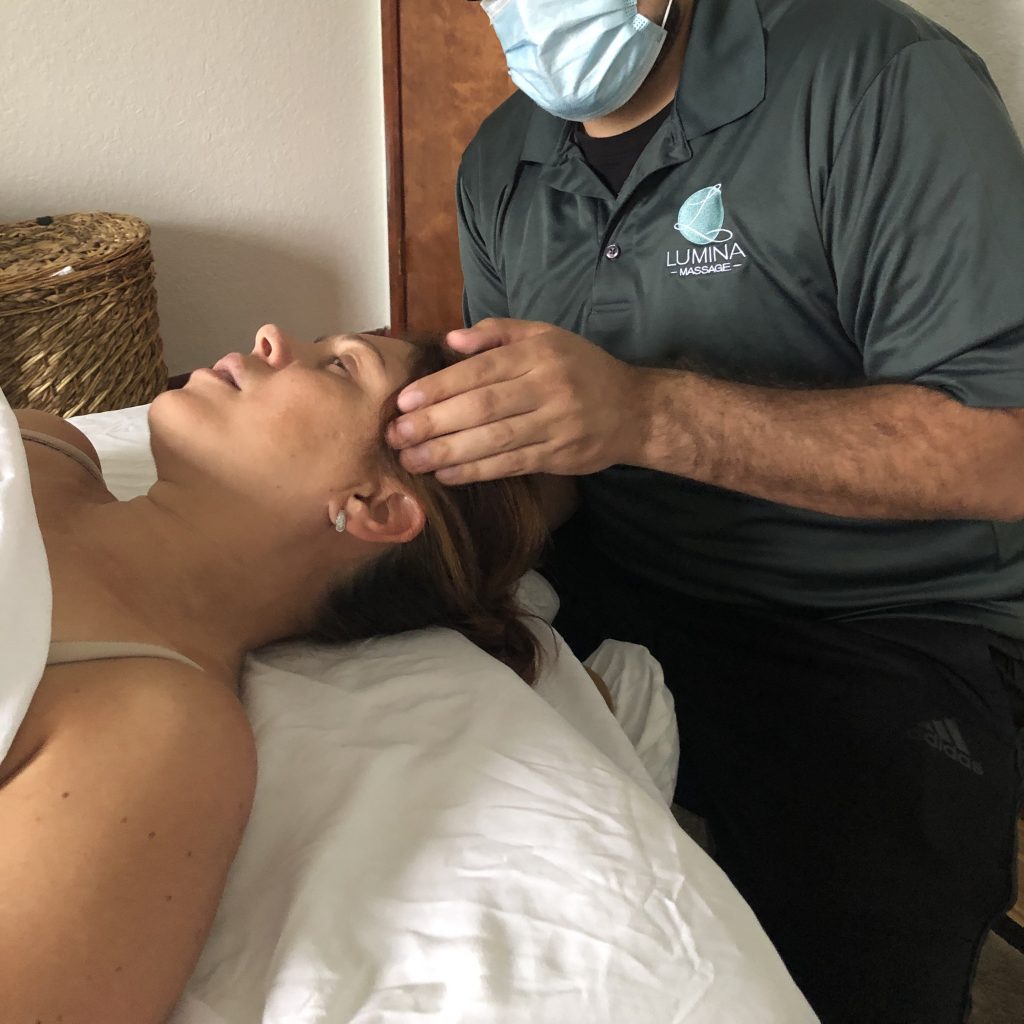
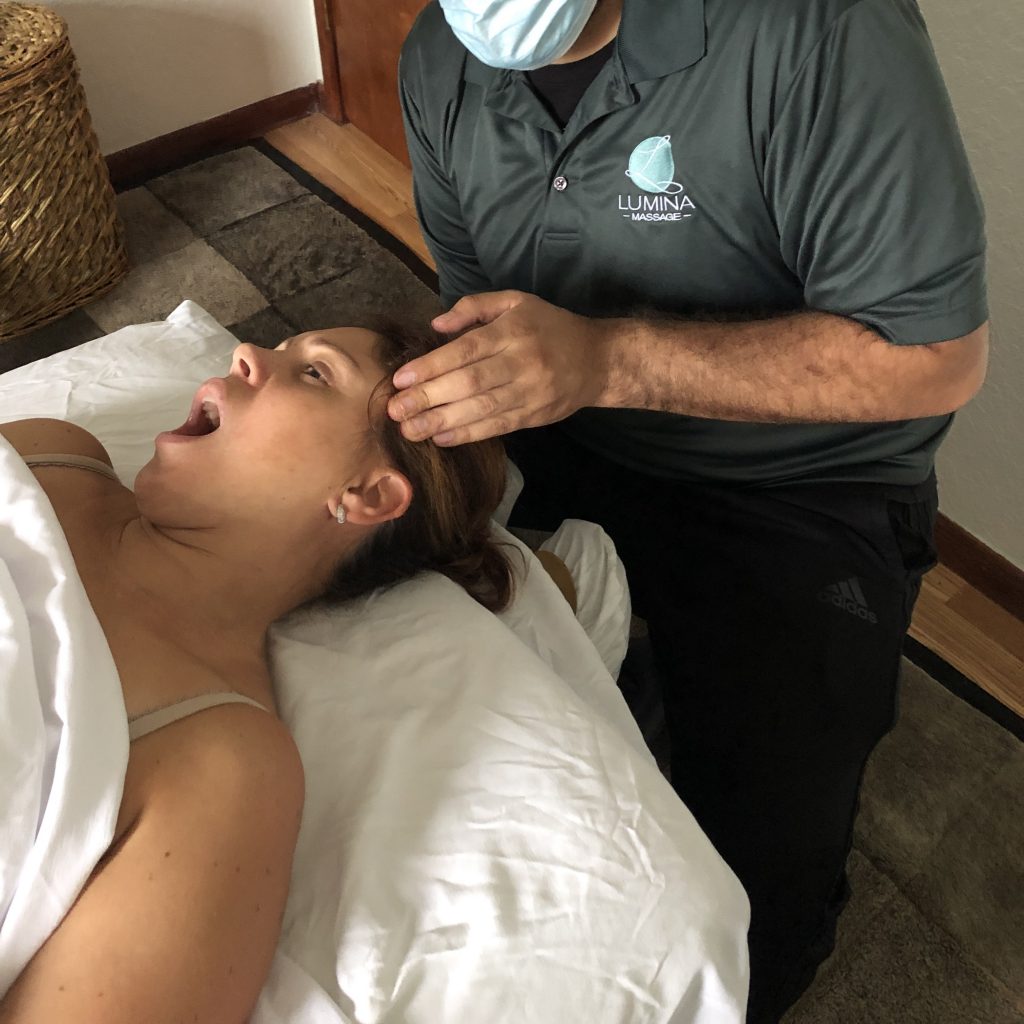
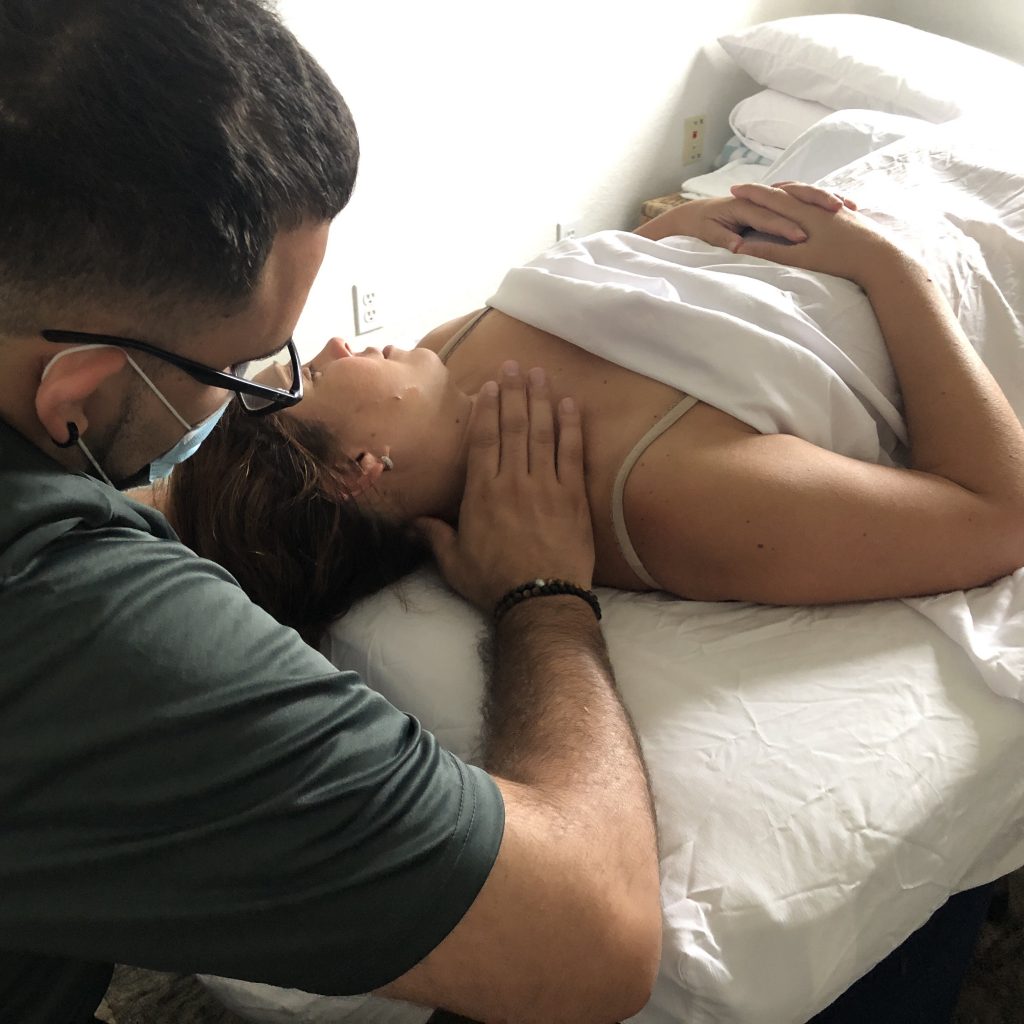
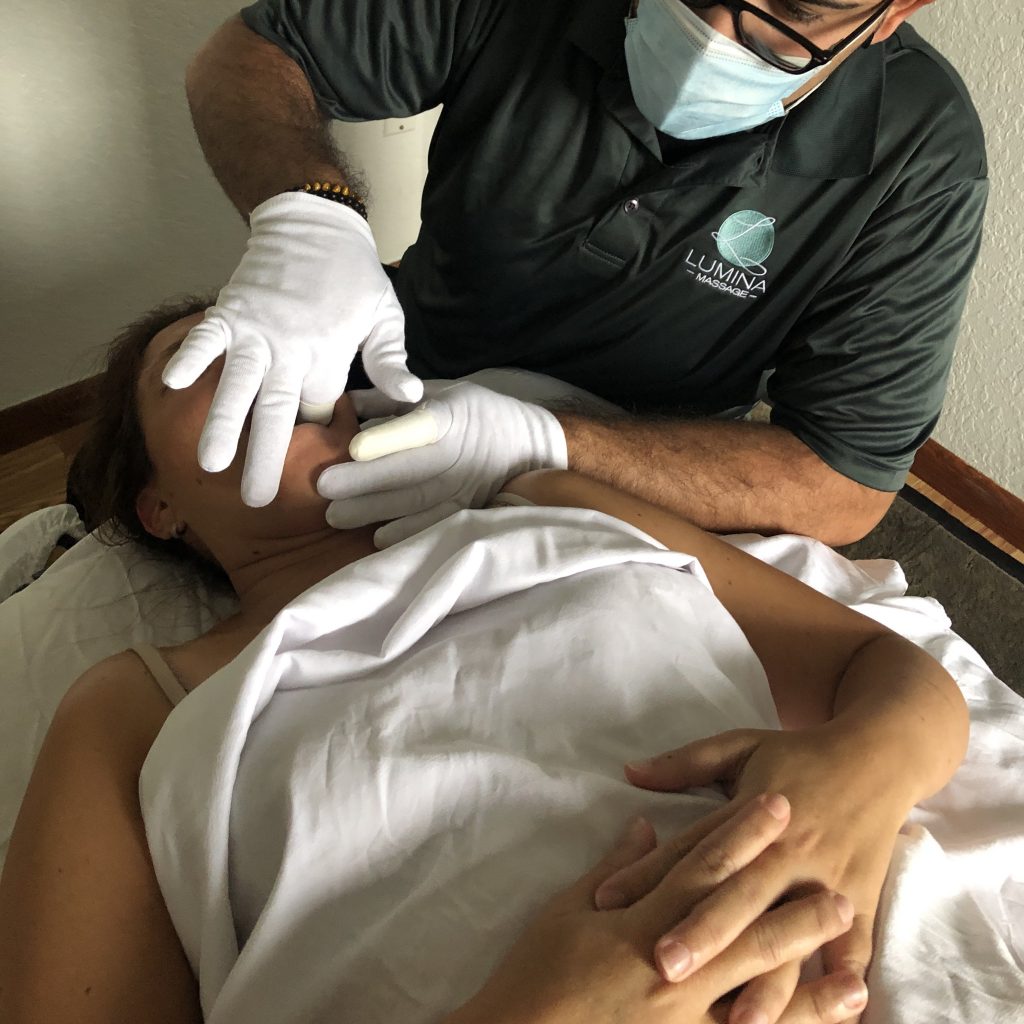
Home Care
If your jaw pain is purely muscular then your home jaw regimen will play a big role in what to do to prevent further damage and speed up recovery.
Thermal Therapy
If there is swelling using ice will bring down the inflammation, if there is tension (which is most common) heat will work best. If there is both a combination of ice and heat can be used.
Take a small hand towel and dampen it with water and heat it. You may use a microwave but monitor it carefully. You may also use a small microwavable heating pad, small enough to lie on the side of your face. Lie on your side and place the heating pad over your jaw. Leave on for 10-15 minutes. Be certain that the heat is not too intense to burn the skin. In the evening apply the same routine with a small ice pack. Monitor how you feel with the use of each one. Which gives most relief? Whichever one it is, continue with that one for a course of seven days.
Self Massage
Jaw muscles may be massaged in the morning and the evening. If you have been receiving massage outside with a therapist, remember the area that bothered you the most. Using the tips of your finger spread a cream or a favorite facial product over your jaw. Pressing inward with your finger pads make small circles up and down the jaw. This may take 5-7 minutes each time.
Preventive Care
Sleep Meditation
Begin to decrease and eliminate stressors 30-60 minutes before before you fall asleep. Focus on things that will relax you. Be mindful of your posture if you work from your bed or even watching a movie or show. Does your neck feel strained? Are your pillows supportive? All these attribute to your posture in bed. Use a sleep mediation podcast or a playlist that will finish after a certain time. Use that time to imagine your jaw muscles and slowly release. Focus on relaxing your entire body and breathing in slowly. Let your mind mediate on releasing the stress of the day and picture your jaw completely relaxed.
Soft Foods
Avoid hard foods that require excessive chewing or bubble gum. Do you have an oral fixation where you chew to manage anxiety? You can shift this focus on another body part to rest your jaw muscles. Crunchy foods are fun and so is the texture but as you’re healing you can plan your meals to be kind to your jaw muscles. Think of fluffy mashed potatoes, blending your favorite squash into a puree, yogurts and smoothies.
There are many delicious and nutritious meals and snacks you can make while you’re healing from your jaw pain. Refrain from nuts, raw veggies such as carrots and celery only for a time.
Vow of Silence
At times our work requires to communicate through speaking. Let others know that they can communicate via texting, email or other creative methods. If may seem silly at first but living with your jaw pain is not something others are experiencing. Protect your time of healing and temporarily use ways to express yourself with talking as much. Again this is only temporary!
References
What You Must Know About Women’s Hormones by Dr. Pamela Wartian Smith,MD, MPH (section on hormonal imbalances)
